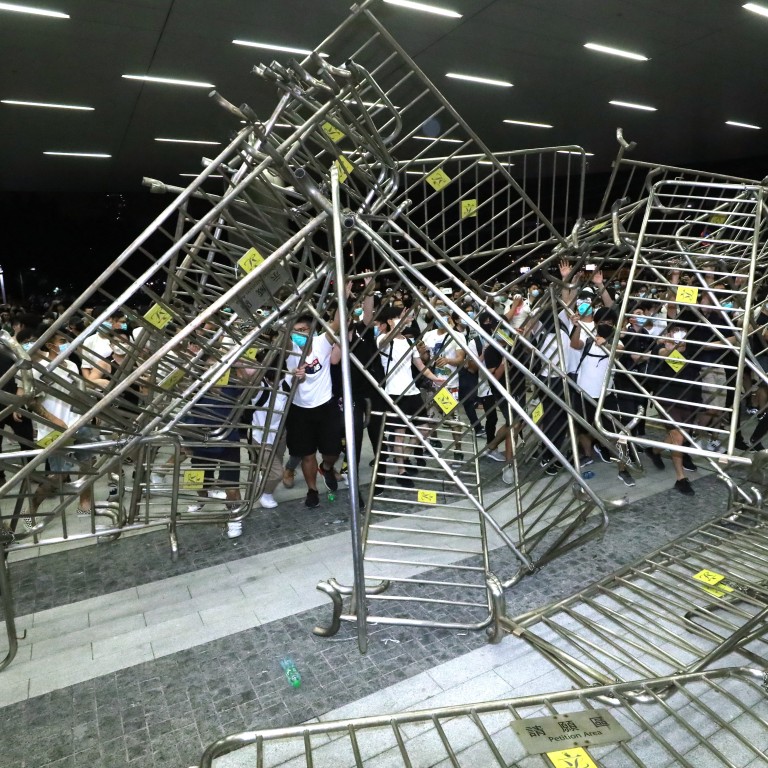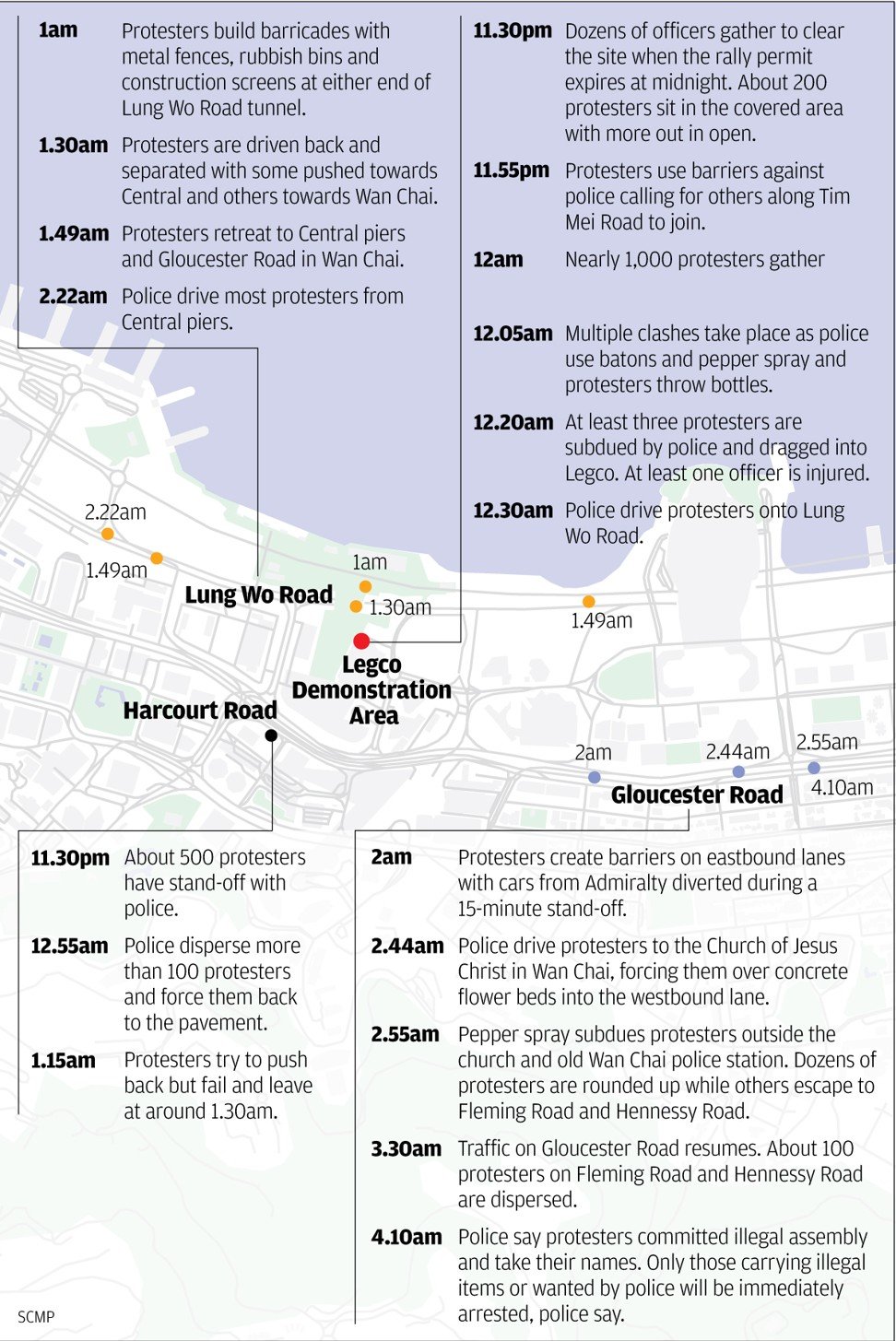
Exclusive | Armed radicals or indecisive and leaderless – who are the protesters who clashed violently with police after Hong Kong extradition bill march?
- Communicating via an encrypted chat group, masked youth who battled with police in early hours of Monday had only a vague plan and often contradicted themselves
- Police see it differently, with 19 ‘prepared and organised’ protesters arrested and dozens of weapons, including lighters and cutters, seized
Organised, prepared, armed and radical – that was the police description of hundreds of young protesters who took on the force across three districts in Hong Kong in the early hours of Monday.
Their organisation was loose but kept secret in an encrypted chat group; their plan was rough and uncoordinated; and their levels of readiness and radicalisation varied, the South China Morning Post has found.
Briefing the media on Monday, Senior Superintendent Kong Wing-cheung from the force’s public relations department sidestepped questions over whether there had been an operational error that allowed protesters the chance to storm the legislature, despite officers knowing there was every possibility of an unlawful assembly after the rally’s permit ended at midnight.
When the march ended at 10pm on Sunday, protesters planned to take over the driveway of Harcourt Road in a scene reminiscent of the Occupy protests in 2014, according to messages in the encrypted channel the Post has seen.
They were stopped by the heavy presence of special tactics forces with pepper spray.
Following the unsuccessful attempt, talk began on the chat group of storming the legislative complex. The protesters appeared to be acting spontaneously and indecisively, and lacking a clear leader.
As it happened: How protest march against the extradition bill turned ugly
Still hesitant, they divided into small groups of five or 10 and continued to discuss their strategy until a call of “Let’s do it, Hongkongers” went up and the decision to escalate their action was taken.
Hundreds of protesters rushed towards the police line in the demonstration area, throwing metal barriers and bottles, and trying to break into the legislative complex.

Police wielding batons and pepper spray pushed back, driving the protesters onto Lung Wo Road, outside the complex, in about half an hour.
Clearance operations by anti-riot police continued for more than three hours, as they forced protesters off Lung Wo Road and divided them into two groups that were channelled in different directions, towards Central and Wan Chai.
If I had gone home and slept, I may have had regrets
During the chase, protesters lacking any plan of action shouted to their peers often contradicting each other with chants of “charge” or “leave”, often at the same time.
Their resistance petered out after police dismantled makeshift roadblocks made of metal barriers, rubbish bins and construction screens.
Police took control of the situation after 3.30am, when 370 protesters were rounded up outside the old Wan Chai police station, while others were dispersed near Central piers and Hennessy Road.
Why did Hongkongers march to protest extradition bill? It’s in their DNA
The clashes left eight officers injured, including one who needed 15 stitches to a cut above his eye. Some 19 protesters were arrested for unlawful assembly and 358 were detained and searched.
Dozens of weapons, such as lighters and cutters, and personal belongings including scissors, cable ties, shirts, masks and goggles were seized.
“They were organised, armed and prepared radical individuals,” said Senior Superintendent Lee Kwai-wah from the Organised Crime and Triad Bureau on Monday.
But several protesters told the Post they were not members of the encrypted platform and they were just keen to shake the government up.
Police should not take reporters from the scene and leave their clearance operation free from media supervision
“I am not in any of those chat groups and I am not in any political party,” said Tina Chu, a 24-year-old bank clerk, who sat on an overturned rubbish bin on Gloucester Road at around 2.40am on Monday, looking at a wall of armoured police about 100 metres (328 feet) away.
Chu joined the confrontation on Lung Wo Road soon after 1am and followed the crowd to Wan Chai.
“I did it because so many people had left the march and the government was not answering our demand [to withdraw the bill],” she said. “All I want is a positive response from the government.”
Alex Wong, 24, who works in the music industry, and Katherine Fung, 25, who works for a press group, stayed after the rally to support the radical protesters until 3am, after seeing posts on online forums.
“I would not use force but I was lending my support to the protesters. If I had gone home and slept, I may have had regrets,” Fung said.
Both said they felt frustrated over the 2014 Occupy movement and, like many of their peers, Sunday was the first time they had joined a protest in the past five years.
The pair said that although the huge turnout and the escalation might not result in any last minute U-turn, they accepted that the struggle for democracy was a long fight that needed protesters to stay as united as possible.
From New York to Brisbane, global rallies express solidarity with Hong Kong
Meanwhile, the Hong Kong Journalists Association and Press Photographers Association urged Commissioner of Police Stephen Lo Wai-chung to provide a reasonable explanation why police used force on journalists reporting during the clashes.
In a statement on Monday, the association said reporters were called “rubbish” and pushed to metal barriers by the police.

One photographer was cut on the face by an object thrown by police, and a large bottle of water carried by a reporter was branded an assault weapon during a bag search.
“Reporters at the scene were discharging their duty to record and report, and exercising their coverage right. Police should not take reporters away from the scene and leave their clearance operation free from media supervision,” the statement said.
Senior superintendent Kong said the force had taken note of the statement and reiterated there were guidelines to remind officers to assist and not obstruct media coverage.
Asked why officers used flashlights on reporters and searched their belongings, senior superintendent Lee said one possible reason was protesters were using fake press cards.




